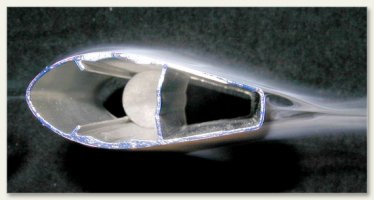Shamwari
Please Contact Admin.
I'm trying to make a really good 3D drawing of an e-39 modified rudder and researching what makes a rudder work well in the conditions we experience with this boat.
I plan to make a new rudder for my boat this spring and want to have the foam blanks cut on a CNC machine before I take it out of the water. To do this I need a very accurate drawing of the outside shape - the inside I will do by hand when I strip the old rudder.
The problem is that I have been getting a lot of information on what makes a rudder work at the speeds we experience. It seems that a fairly safe way to go is to base it on a NACA 4 series airfoil ( think old slow aircraft wings).
I want to extend it about 2.5 inches down in the hope that this will bring some rudder surface into the area where it will be more influenced by the propwash.
I also want to extend the back rearward about 4.5 inches.
However I have some questions and I thought some people may have some experience that would be helpful.
Should I go deeper than 2.5" - I understand that depth is more important than width ( think longer wing)
What is the strange flatter area at the top of the rudder on an e-39 for. (It may be that because it is behind the aft edge of the keel that it is only a section of trailing edge)
I am planning to make the curve on the front of the rudder like an extension of the origional rudder but make the very bottom flat in a scaled down shape of the NACA 4 profile. This will make it a little stronger and I think it will keep it providing "lift" better.
I am also planning to make the aft edge of the rudder flat rather than tapering it to a near sharp edge. It is stronger and the square edge might help with trailing vortices ( it does with Kamm back cars).
I know this is more technical than we usually get, but i'm hoping someone has been through this process and will have some insight into what actually works well and what doesn't.
I will send the drawings into the sight after I'm finished so anyone can use them if they wish to.
John Gleadle
I plan to make a new rudder for my boat this spring and want to have the foam blanks cut on a CNC machine before I take it out of the water. To do this I need a very accurate drawing of the outside shape - the inside I will do by hand when I strip the old rudder.
The problem is that I have been getting a lot of information on what makes a rudder work at the speeds we experience. It seems that a fairly safe way to go is to base it on a NACA 4 series airfoil ( think old slow aircraft wings).
I want to extend it about 2.5 inches down in the hope that this will bring some rudder surface into the area where it will be more influenced by the propwash.
I also want to extend the back rearward about 4.5 inches.
However I have some questions and I thought some people may have some experience that would be helpful.
Should I go deeper than 2.5" - I understand that depth is more important than width ( think longer wing)
What is the strange flatter area at the top of the rudder on an e-39 for. (It may be that because it is behind the aft edge of the keel that it is only a section of trailing edge)
I am planning to make the curve on the front of the rudder like an extension of the origional rudder but make the very bottom flat in a scaled down shape of the NACA 4 profile. This will make it a little stronger and I think it will keep it providing "lift" better.
I am also planning to make the aft edge of the rudder flat rather than tapering it to a near sharp edge. It is stronger and the square edge might help with trailing vortices ( it does with Kamm back cars).
I know this is more technical than we usually get, but i'm hoping someone has been through this process and will have some insight into what actually works well and what doesn't.
I will send the drawings into the sight after I'm finished so anyone can use them if they wish to.
John Gleadle


